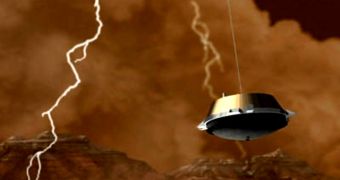A group of astronomers says that upcoming missions aimed at exploring Titan might also feature instruments or detectors capable of searching for thunders. Finding signs that the atmospheric phenomenon takes place will make it easier for scientists to find lightning.
The atmosphere around Saturn's largest moon is tremendously complex and interesting. It is able to support the existence of a few different chemical cycles, and can even produce rain. Granted, it's made of liquid hydrocarbons such as methane or ethane, but it's rain nonetheless.
For many years, experts at space agencies around the world have proposed missions to the surface of this moon, which is arguably one of the most interesting objects in our solar system. It's also one of the places where finding alien life is possible.
However, studying Titan is not that easy, astronomers are quick to point out. At average temperatures of minus 190 degrees Celsius, water freezes so hard that it becomes harder than granite. The atmosphere is so hazy, that instruments operating in visible-light cannot see through.
The NASA Cassini orbiter, for example, is using radar imaging to see Titan's surface. The space probe has been analyzing Saturn, its rings and its moons since July 1, 2004, when it achieved orbital insertion around the gas giant.
For a potential mission to the moon, experts propose a new way of detecting thunder. The methods used will have to be different than those employed by scientists working on Earth. The two atmospheres are very different from each other, Space reports.
Experts now propose that a future spacecraft would analyze sound waves emanating from Titan's clouds. The way these waves travel through the atmosphere is still an open question, but experts are convinced that more studies will allow them to model Titan's atmosphere appropriately.
The interesting thing is that the object's atmosphere is also better than Earth's from an acoustical standpoint. “Sound carries farther on Titan than on Earth, or even Mars or Venus,” says Andri Petculescu, a researcher who worked on two new studies proposing the mission.
“You can't bring any microphone off the shelf, designed for Earth, and assume it would work on Titan without modifications. Future missions would have microphones tailored for Titan's conditions,” he adds.
At this time, the Titan Mare Explorer (TiME) mission is being considered by NASA, for launch in 2016. However, it's still unknown whether it will be selected or not. Even if it is, it does not include an instrument dedicated to acoustical research.

 14 DAY TRIAL //
14 DAY TRIAL //